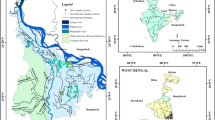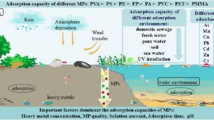Abstract
This study investigated the sorption behaviour of natural (N peat) and HCl-acid-modified peat (HCl peat) for contaminants in water collected at a mine site in northern Finland. Batch sorption experiments were conducted at room temperature and at 5 °C. Characterization of the sorbents by FTIR and XPS revealed no substantial change in the peat’s functional groups due to the acid treatment. Generally, the N peat was a more efficient sorbent for the mine water, although the HCl peat exhibited better nickel uptake capacity (21 mg Ni/g) than the N peat (16 mg Ni/g) from synthetic water. This is attributed to the lower equilibrium pH in samples treated with the HCl peat as well as the water’s different chemical composition. At room temperature, the N peat removed As(V) (80%) and Ni (85%) at low dosage (1–2 g/L), whereas the HCl peat presented good removal of As(V) (80%) at low dosage (1 g/L) but did not achieve satisfactory removal of Ni, even at a higher dosage (4 g/L). The performance of both sorbents was significantly affected by contact time. Ni removal by N peat increased substantially with contact time whereas removals achieved by HCl peat increased slightly up to 60 min, but decreased significantly at 24 h. Unlike with HCl peat, the N peat was less efficient in the experiments conducted at 5 °C. Overall, for both sorbents, As(V) and Ni were the most efficiently removed contaminants from the mine water. HCl peat had slightly better settling properties, however, both products settled poorly, thus rendering the studied mixing and settling system unsuitable for the proposed application. Nevertheless, both peat products, and especially the N peat, exhibited high contaminant removal potential and could represent a cost-effective and sustainable option for mine water treatment.
Zusammenfassung
Diese Studie untersuchte das Sorptionsverhalten von natürlichem (N-Torf) und Salzsäure-modifiziertem (HCl-Torf) Torf für Verunreinigungen in Wässern, die in einer Mine in Nordfinnland gesammelt wurden. Säulensorptionsexperimente wurden bei Raumtemperatur und bei 5 Grad Celsius durchgeführt. Die Charakterisierung des Sorbens durch FTIR und XPS ergab keine wesentliche Veränderung der funktionellen Gruppen des Torfs infolge der Säurebehandlung. Im Allgemeinen war der N-Torf ein effizienteres Sorptionsmittel für das Grubenwasser, obwohl der HCl-Torf für synthetisches Wasser eine bessere Nickelaufnahmekapazität (21 mg Ni / g) aufwies als der N-Torf (16 mg Ni / g). Dies wird auf den niedrigeren Gleichgewichts-pH in Proben, die mit dem HCl-Torf behandelt wurden, sowie auf die unterschiedliche chemische Zusammensetzung des Wassers zurückgeführt. Bei Raumtemperatur beseitigte der N-Torf As(V) (80%) und Ni (85%) bei niedriger Dosierung (1-2 g/l), während der HCl-Torf eine gute Beseitigung von As(V) (80%) bei niedriger Dosierung (1 g/l) jedoch keine zufriedenstellende Beseitigung von Ni, selbst bei einer höheren Dosierung (4 g/l), erreichte. Die Leistung beider Sorbenzien wurde signifikant von der Kontaktzeit beeinflusst. Die Ni-Sorption durch N-Torf stieg im Wesentlichen mit der Kontaktzeit an, während die durch HCl-Torf erreichte Sorption geringfügig bis 60 min anstieg. aber nach 24 Stunden deutlich zurückgegangen. Anders als bei HCl-Torf war der N-Torf in den bei 5ºC durchgeführten Experimenten weniger effizient. Insgesamt waren As(V) und Ni für beide Sorbenzien die am effektivsten beseitigten Verunreinigungen aus dem Grubenwasser. HCl-Torf hatte etwas bessere Sorptionseigenschaften, jedoch waren beide Produkte schlecht, was das untersuchte Misch- und Sorptionssystem für die vorgeschlagene Anwendung ungeeignet machte. Nichtsdestoweniger zeigten beide Torfprodukte und insbesondere der N-Torf ein hohes Potenzial für die Adsorption von Schadstoffen und könnten eine kostengünstige und nachhaltige Option für die Aufbereitung von Grubenwasser darstellen.
Resumen
La irrupción de agua es un desastre potencial en la mina de oro Sanshandao, que está localizada en la costa del mar BoHai. Se estableció un modelo conceptual basado eEste estudio investigó sobre el comportamiento en sorción de turba natural (N) y turba modificada con HCl sobre los contaminantes del agua colectada en un sitio minero en el norte de Finlandia. Los experimentos de sorción en batch fueron realizados a temperatura ambiente y a 5°C. La caracterización de los sorbentes por FTIR y XPS reveló que no hubo cambios sustanciales en los grupos funcionales de la turba luego del tratamiento ácido. En general, la turba N fue más eficiente aunque la turba modificada exhibió mejor capacidad de sorción de níquel (21 mg Ni/g) que la turba N (16 mg Ni/g) a partir de agua sintética. Esto se atribuye al menor pH de equilibrio en las muestras tratadas con la turba modificada así como las diferentes composiciones químicas del agua. A temperatura ambiente, la turba natural removió As(V) (80%) y Ni (85%) a bajas concentraciones (1-2 g/L), mientras que la turba modificada presentó una Buena remoción de As(V) (80%) a baja concentración (1 g/L) pero no logró una satisfactoria remoción de Ni, aún a altas concentraciones (4 g/L). El comportamiento de ambos sorbentes fue afectado significativamente por el tiempo de contacto. La remoción de Ni por turba natural se incrementó sustancialmente con el tiempo de contacto mientras que las remociones alcanzadas con la turba modificadas se incrementaron ligeramente hasta los 60 min pero decrecieron significativamente a las 24 h. A diferencia de la turba modificada, la turba natural fue menos eficiente en los experimentos que se realizaron a 5°C. Globalmente, para ambos sorbentes, As(V) y Ni fueron los removidos más eficientemente desde el agua de mina. La turba modificada tuvo propiedades de decantación algo mejores, sin embargo fue deficiente para ambos productos indicando que el sistema estudiado de mezcla y sedimentación no es adecuado para la aplicación propuesta. En cualquier caso, ambos turbas y especialmente la natural, exhibieron un alto potencial de remoción de contaminantes y podrían representar una opción sustentable y de bajo costo para el tratamiento de agua de minas.
摘要
研究了天然泥炭(N peat)和改良盐酸泥炭(HCl-acid-modified peat, HCl peat)对芬兰北部矿坑水污染物的吸附行为。批次吸附试验条件为室温和5°C。吸附剂的傅立叶变换红外光谱(FTIR)和X射线光电子能谱(XPS)测试表明,酸处理并未根本改变泥炭功能团。虽然盐酸泥炭比天然泥炭对合成污水的镍吸附能力(分别21 mg Ni/g和16 mg Ni/g)更强,但通常认为天然泥炭是更有效的矿井水处理吸附剂。这主要归因于盐酸泥炭处理水样的低pH平衡和不同水化学组分。在室温条件下,低剂量(1-2g/L)天然泥炭去除砷(V)80%和镍85%;虽然盐酸泥炭表现出更好的低剂量(1g/L)条件去除砷(V)效果(80%),但是高剂量(4g/L)条件下镍去除效果仍然不佳。两种吸附剂性能明显受接触时间影响。天然泥炭去除镍效果随接触时间延长而显著增强,而盐酸泥炭去除镍效果在60分钟后仅微弱增强,更在24小时以后大幅降低。与盐酸泥炭不同,天然泥炭在5°C条件下吸附效率较低。总之,两种吸附剂都可最有效地从矿井水中去除砷(V)和镍。两种产品尤其是天然泥炭表现出更高的污染物去除潜力,将是经济、可持续矿井水处理选择。






Similar content being viewed by others
References
Andriesse JP (1988) Nature and management of tropical peat soils. FAO Bulletin 59, Food and Agriculture Organization of the United Nations, Rome
Ansone-Bertina L, Klavins M (2016) Sorption of V and VI group metalloids (As, Sb, Te) on modified peat sorbents. Open Chem 14:46–59
Araújo CST, Carvalho DC, Rezende HC, Almeida ILS, Coelho LM, Coelho NMM, Marques TL, Alves VN (2013) Bioremediation of waters contaminated with heavy metals using Moringa oleifera seeds as biosorbent. In: Patil Y, Rao P (eds) Applied bioremediation—active and passive approaches. InTech. https://doi.org/10.5772/56157
Baileyab SE, Olinb TJ, Brickab RM. Adriana DD (1999) A review of potentially low-cost sorbents for heavy metals. Water Res 33(11):2469–2479
Barakat MA (2011) New trends in removing heavy metals from industrial wastewater. Arab J Chem 4(4):361–377
Bartczak P, Norman M, Klapiszewski L, Karwańska N, Kawalec M, Baczyńska M, Wyokowski M, Zdarta J, Ciesielczyk F, Jesionowski T (2015) Removal of nickel (II) and lead (II) ions from aqueous solutions using peat as low-cost adsorbent: a kinetic and equilibrium study. Arab J Chem. https://doi.org/10.1016/j.arabjc.2015.07.018
Batista APS, Romão LPC, Arguelho MLPM, Garcia CAB, Alves JPH, Passos EA, Rosa AH (2009) Biosorption of Cr(III) using in natura and chemically treated tropical peats. J Hazard Mater 163(2–3):517–523
Bogush AA, Voronin VG, Tikhova VD, Anoshin GN (2016) Acid rock drainage remediation and element removal using a peat-humic agent with subsequent thermal treatment of the metal-organic residue. Mine Water Environ 35:536–546
Brown PA, Gill SA, Allen SJ (2000) Metal removal from wastewater using peat. Water Res 34(16):3907–3916
Bulgariu L, Bulgariu D, Macoveanu M (2011) Adsorptive performances of alkaline treated peat for heavy metal removal. Sep Sci Technol 46(6):1023–1033
Bulgariu L, Bulgariu D, Macoveanu M (2012) Characteristics of sorption of uncomplexed and complexed Pb(II) from aqueous solutions onto peat. Chem Pap 66(4):239–247
Crist RH, Martin JR, Chonko J, Crist DR (1996) Uptake of metals on peat moss: an ion exchange process. Environ Sci Technol 30(8):2456–2461
Eger P, Jones P, Green D (2015) Treating high flow discharges with a modular peat-based sorption media system. In: Cathcart J, Corser P, Evans D, Hutchison I, Johndrow T, Martin T, McLeod H, Obermeyer J, Ramey D, Royle M, Shaw S, Smith L, van Zyl D (eds) Proc mine water solutions in extreme environments. InfoMine, Vancouver
Filella M, Belzile N, Chen Y-W (2002) Antimony in the environment: a review focused on natural waters: II. Relevant solution chemistry. Earth Sci Rev 59:265–285
Fu F, Wang Q (2011) Removal of heavy metal ions from wastewaters: a review. J Environ Manag 92(3):407–418
Gogoi H, Leiviskä T, Heiderscheidt E, Postila H, Tanskanen J (2017) Removal of metals from mining wastewaters by utilization of natural and modified peat as sorbent materials. In: Wolkersdorfer C, Sartz L, Sillanpää M, Häkkinen A (eds) Proc 13th international mine water assoc congress: mine water and circular economy, vol 1. LUT Scientific and Expertise Publ, Lappeenranta, 218–226
Gosset T, Trancart J-L, Thévenot DR (1986) Batch metal removal by peat: kinetics and thermodynamics. Water Res 20(1):21–26
Hergert H (1960) Infrared spectra of lignin and related compounds. II. Conifer lignin and model compounds. J Org Chem 25(3):405–413
Ho YS, Wase DAJ, Forster CF (1995) Batch nickel removal from aqueous solution by Spagnum moss peat. Water Res 29(5):1327–1332
Kalmykova Y, Strömvall A-M, Steenari B-M (2008) Adsorption of Cd, Cu, Ni, Pb and Zn on Spagnum peat from solutions with low metal concentrations. J Hazard Mater 152(2):885–891
Kelemen SR, Afeworki M, Gorbaty ML, Kwiatek PJ, Sansone M, Walters CC, Cohen AD (2006) Thermal transformations of nitrogen and sulfur forms in peat related to coalification. Energy Fuels 20(2):635–652
Keränen A, Leiviskä T, Zinicovscaia I, Frontasyeva MV, Hormi O, Tanskanen J (2015) Quaternized pine sawdust in the treatment of mining wastewater. Environ Technol 37(11):1390–1397
Kløve B (1997) Settling of peat in sedimentation ponds. J Environ Sci Health A 32(5):1507–1523
Leiviskä T, Khalid MK, Gogoi H, Tanskanen J (2018) Enhancing peat metal sorption and settling characteristics. Ecotoxicol Environ Saf 148:346–351
Nádáská G, Lesný J, Michalík I (2012) Environmental aspect of manganese chemistry. HEJ: ENV-100702-A. http://heja.szif.hu/ENV/ENV-100702-A/env100702a.pdf. Accessed Mar 2017
Nakanishi K (1962) Infrared absorption spectroscopy-practical. Nankodo Co Ltd, Tokyo
Nicomel NR, Leus K, Folens K, Voort PVD, Laing GD (2015) Technologies for arsenic removal from water: current status and future perspectives. Int J Environ Res Pub He 13(1):1–24
Ong HL, Swanson VE (1966) Adsorption of copper by peat, lignite, and bituminous coal. Econ Geol 61(7):1214–1231
Polack R, Chen Y-W, Belzile N (2009) Behavior of Sb(V) in the presence of dissolved sulphide under controlled anoxic conditions. Chem Geol 262:179–185
Qin F, Wen B, Shan X-Q, Xie Y-N, Liu T, Zhang S-Z, Khan SU (2006) Mechanisms of competitive adsorption of Pb, Cu and Cd on peat. Environ Pollut 144(2):669–680
Sobhanardakani S, Parvizimosaed H, Olyaie E (2013) Heavy metals removal from wastewaters using organic solid waste-rice husk. Environ Sci Pollut Res 20:5265–5271
Williams DH, Fleming I (1995) Spectroscopic methods in organic chemistry, 5th edn. McGraw-Hill, London
Yang JS, Park YT, Baek K, Choi J (2010) Removal of metal ions from aqueous solutions using sawdust modified with citric acid or tartaric acid. Sep Sci Technol 45(12–13):1963–1974
Zheng L, Zhu C, Dang Z, Zhang H, Yi X, Liu C (2012) Preparation of cellulose derived from corn stalk and its application for cadmium ion adsorption from aqueous solution. Carbohydr Polym 90:1008–1015
Acknowledgements
The study has been conducted as part of the Min-North project “Development, Evaluation and Optimization of Measures to Reduce the Impact on the Environment from Mining Activities in Northern Regions,” funded by the Interreg Nord 2014–2020 program.
Author information
Authors and Affiliations
Corresponding author
Rights and permissions
About this article
Cite this article
Gogoi, H., Leiviskä, T., Heiderscheidt, E. et al. Тhe Еffectiveness of Metal and Metalloid Sorption from Mining Influenced Waters by Natural and Modified Peat. Mine Water Environ 37, 734–743 (2018). https://doi.org/10.1007/s10230-018-0525-1
Received:
Accepted:
Published:
Issue Date:
DOI: https://doi.org/10.1007/s10230-018-0525-1




